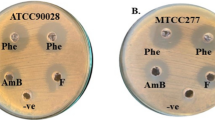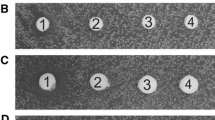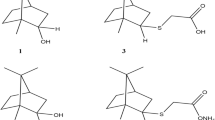Abstract
Candida albicans is a major invasive pathogen, and the development of strains resistant to conventional antifungal agents has been reported in recent years. We evaluated the antifungal activity of 44 compounds against Candida strains. Magnoflorine showed the highest growth inhibitory activity of the tested Candida strains, with a minimum inhibitory concentration (MIC) of 50 μg/mL based on microdilution antifungal susceptibility testing. Disk diffusion assay confirmed the antifungal activity of magnoflorine and revealed that this activity was stable over 3 days compared to those of berberine and cinnamaldehyde. Cytotoxicity testing showed that magnoflorine could potentially be used in a clinical setting because it didn’t have any toxicity to HaCaT cells even in 200 μg/mL of treatment. Magnoflorine at 50 μg/mL inhibited 55.91 ± 7.17% of alpha-glucosidase activity which is required for normal cell wall composition and virulence of Candida albicans. Magnoflorine also reduced the formation of C. albicans’ biofilm. Combined treatment with magnoflorine and miconazole decreased the amount of miconazole required to kill various Candida albicans. Therefore, magnoflorine is a good candidate lead compound for novel antifungal agents.



Similar content being viewed by others
References
Alastruey-Izquierdo A, Melhem MS, Bonfietti LX, Rodriguez-Tudela JL (2015) Susceptibility test for fungi: clinical and laboratorial correlations in medical mycology. Rev Inst Med Trop Sao Paulo 57:57–64
Balouiri M, Sadiki M, Ibnsouda SK (2016) Methods for in vitro evaluating antimicrobial activity: a review. J Pharm Anal 6:71–79
Bates S, Hughes HB, Munro CA, Thomas WP, MacCallum DM, Bertram G, Atrih A, Ferguson MA, Brown AJ, Odds FC, Gow NA (2006) Outer chain N-glycans are required for cell wall integrity and virulence of Candida albicans. J Biol Chem 281:90–98
Bischoff H (1995) The mechanism of alpha-glucosidase inhibition in the management of diabetes. Clin Invest Med 18:303–311
Bramono K, Tsuboi R, Ogawa H (1995) A carbohydrate-degrading enzyme from Candida albicans: correlation between a-glucosidase activity and fungal growth. Mycose 38:349–353
CCLS document M27-A3 (2008) National Committee for Clinical Laboratory Standards, reference method for broth dilution antifungal susceptibility testing of yeasts. Pennsylvania, USA
Chandra J, Long L, Isham N, Mukherjee PK, DiSciullo G, Appelt K, Ghannoum MA (2018) In vitro and in vivo activity of a novel catheter lock solution against bacterial and fungal biofilms. Antimicrob Agents Chemother 4:AAC.00722 – 18
Chen JH, Du ZZ, Shen YM, Yang YP (2009) Aporphine alkaloids from Clematis parviloba and their antifungal activity. Arch Pharm Res 32:3–5
Cornely OA, Lass-Florl C, Lagrou K, Valentina AA (2017) Improving outcome of fungal diseases—guiding experts and patients towards excellence. Mycoses 60:420–425
Dhale RP, Ghorpade MV, Dharmadhikari CA (2014) Comparison of various methods used to detect biofilm production of Candida species. J Clin Diagn Res 8:DC18–DC20
Drogari-Apiranthitou M, Mantopoulou FD, Skiada A, Kanioura L, Grammatikou M, Vrioni G, Mitroussia-Ziouva A, Tsakris A, Petrikkos G (2012) In vitro antifungal susceptibility of filamentous fungi causing rare infections: synergy testing of amphotericin B, posaconazole and anidulafungin in pairs. J Antimicrob Chemother 67:1937–1940
EUCAST (2017) Antimicrobial susceptibility testing EUCAST disk diffusion method. ESCMID Manual v 6:0
Haque F, Alfatah M, Ganesan K, Bhattacharyya MS (2016) Inhibitory effect of sophorolipid on Candida albicans biofilm formation and hyphal growth. Sci Rep 6:23575
Hisatomi E, Matsui M, Kubota K, Kobayashi A (2000) Antioxidative activity in the pericarp and seed of Japanese pepper (Xanthoxylum piperitum DC). J Agric Food Chem 48:4924–4928
Klis FM, Groot PD, Hellungwerf K (2001) Molecular organization of the cell wall of Candida albicans. Med Mycol 39:1–8
Küpeli E, Koşar M, Yeşilada E, Hüsnü K, Başer C (2002) A comparative study on the anti-inflammatory, antinociceptive and antipyretic effects of isoquinoline alkaloids from the roots of Turkish Berberis species. Life Sci 72:645–657
Li C, Wang M-H (2014) Potential biological activities of magnoflorine: a compound from Aristolochia debilis Sieb. et Zucc. Korean J Plant Resour 27:223–228
Lozano-Chiu M, Nelson PW, Paetznick VL, Rex JH (1999) Disk diffusion method for determining susceptibilities of Candida spp. to MK-0991. J Clin Microbiol 37:1625–1627
Mumma JO, Chhay JS, Ross KL, Eaton JS, Newell-Litwa KA, Fridovich-Keil JL (2008) Distinct roles of galactose-1P in galactose-mediated growth arrest of yeast deficient in galactose-1P uridylyltransferase (GALT) and UDP-galactose 4′-epimerase (GALE). Mol Genet Metab 93:160–171
Ngan LTM, Moon JK, Shibamoto T, Ahn YJ (2012) Growth-inhibiting, bactericidal, and urease inhibitory effects of Paeonia lactiflora root constituents and related compounds on antibiotic-susceptible and -resistant strains of Helicobacter pylori. J Agric Food Chem 60:9062–9073
Nikolić M, Vasić S, Đurđević J, Stefanović O, Čomić L (2014) Antibacterial and anti-biofilm activity of ginger (Zingiber officinale (Roscoe)) ethanolic extract. Kragujevac J Sci 36:129–136
Ora-Montes HM, Bates S, Netea MG et al (2007) Endoplasmic reticulum alpha-glycosidases of Candida albicans are required for N glycosylation, cell wall integrity, and normal host-fungus interaction. Eukaryot Cell 6:2184–2193
Pal M (2017) Morbidity and mortality due to fungal infections. J Appl Microbiol Biochem 1:1–3
Patel MB, Mishra SM (2012) Magnoflorine from Tinospora cordifolia stem inhibits α-glucosidase and is antiglycemic in rats. J Funct Foods 4:79–86
Pootong A, Norrapong B, Cowawintaweewat S (2017) Antifungal activity of cinnamaldehyde against Candida albicans. Southeast Asian J Trop Med 48:150–158
Sato T, Kishi M, Suda M et al (2017) Prevalence of Candida albicans and non-albicans on the tongue dorsa of elderly people living in a post-disaster area: a cross-sectional survey. BMC Oral Health 17:51
Shai LJ, Masoko P, Mokgotho MP, Magano SR, Mogale AM, Boaduo N, Eloff JN (2010) Yeast alpha glucosidase inhibitory and antioxidant activities of six medicinal plants collected in Phalaborwa, South Africa. S Afr J Bot 76:465–470
Shao J, Shi G, Wang TM, Wu DQ, Wang CZ (2016) Antiproliferation of berberine in combination with fluconazole from the perspectives of reactive oxygen species, ergosterol and drug efflux in a fluconazole-resistant Candida tropicalis isolate. Front Microbiol 7:15–16
Shin YK, Kim KY (2016) Macelignan inhibits bee pathogenic fungi Ascophaera apis growth through HOG1 pathway. Braz J Med Biol Res 49:5313
Shin JH, Kee SJ, Shin MG, Kim SH, Shin DH, Lee SK, Suh SP, Ryang DW (2002) Biofilm production by isolates of Candida species recovered from nonneutropenic patients: comparison of bloodstream isolates with isolates from other sources. J Clin Microbiol 30:1244–1248
Siddiqua S, Anusha BA, Ashwini LS, Negi PS (2015) Antibacterial activity of cinnamaldehyde and clove oil: effect on selected foodborne pathogens in model food systems and watermelon juice. J Food Sci Technol 52:5834–5841
Singh S, Srivastava R, Choudhary S (2010) Antifungal and HPLC analysis of the crude extracts of Acorus calamus, Tinospora cordifolia and Celestrus paniculatus. Int J Agric Technol 6:149–158
Taff HT, Nett JE, Andes DR (2012) Comparative analysis of Candida biofilm quantitation assays. Med Mycol 50:214–218
Tavares LdC, Zanon G, Weber AD et al (2014) Structure-activity relationship of benzophenanthridine alkaloids from Zanthoxylum rhoifolium having antimicrobial activity. PLoS ONE 9:97000
Whaley SG, Berkow EL, Rybak JM, Nishimoto AT, Barker KS, Rogers PD (2016) Azole antifungal resistance in Candida albicans and emerging non-albicans Candida species. Front Microbiol 7:02173
Zida A, Bamba S, Yacouba A, Ouedraogo-Traore R, Guiguemdé RT (2017) Anti-Candida albicans natural products, sources of new antifungal drugs: a review. J Mycol Med 27:01–19
Zorić N, Kosalec I, Tomić S, Bobnjarić I, Jug M, Vlainić T, Vlainić J (2017) Membrane of Candida albicans as a target of berberine. BMC Complement Altern Med 17:268
Acknowledgements
This research was supported by the Basic Science Research Program through grants from the National Research Foundation of Korea (NRF) funded by the Ministry of Education (NRF-2015R1D1A1A01061225) and IPET (116094-03-1-SB010).
Author information
Authors and Affiliations
Corresponding author
Ethics declarations
Conflict of interest
The authors declare that the research was conducted in the absence of any commercial or financial relationships that could be construed as potential conflicts of interest.
Electronic supplementary material
Below is the link to the electronic supplementary material.
Rights and permissions
About this article
Cite this article
Kim, J., Ha Quang Bao, T., Shin, YK. et al. Antifungal activity of magnoflorine against Candida strains. World J Microbiol Biotechnol 34, 167 (2018). https://doi.org/10.1007/s11274-018-2549-x
Received:
Accepted:
Published:
DOI: https://doi.org/10.1007/s11274-018-2549-x




